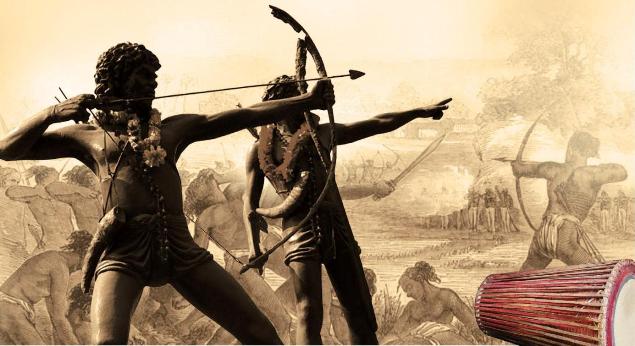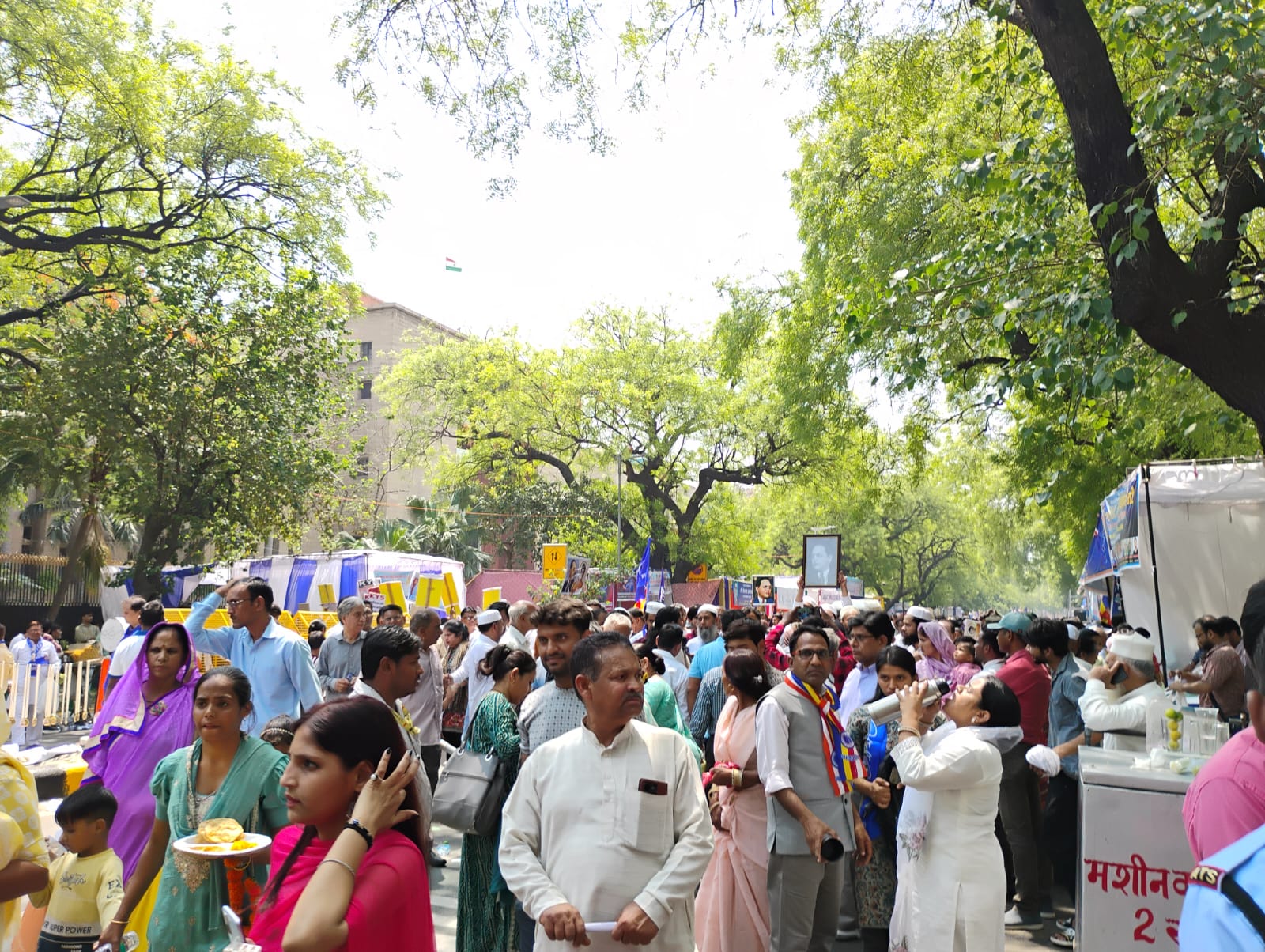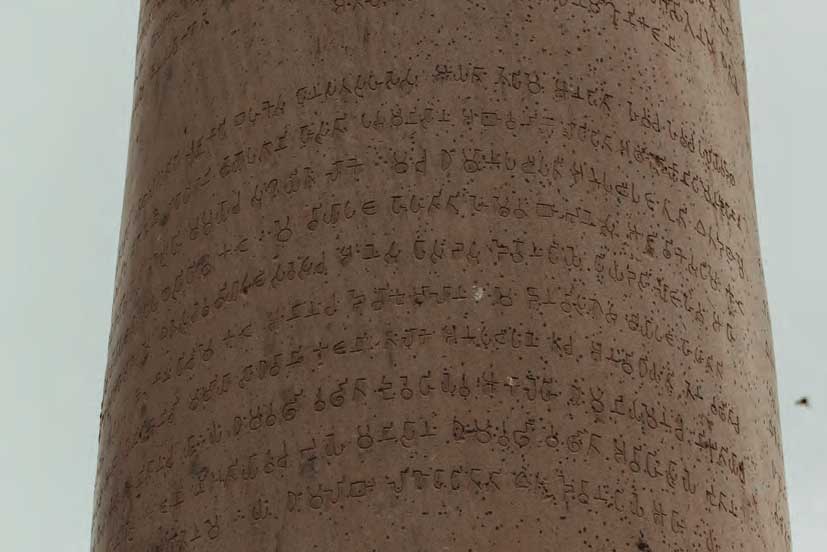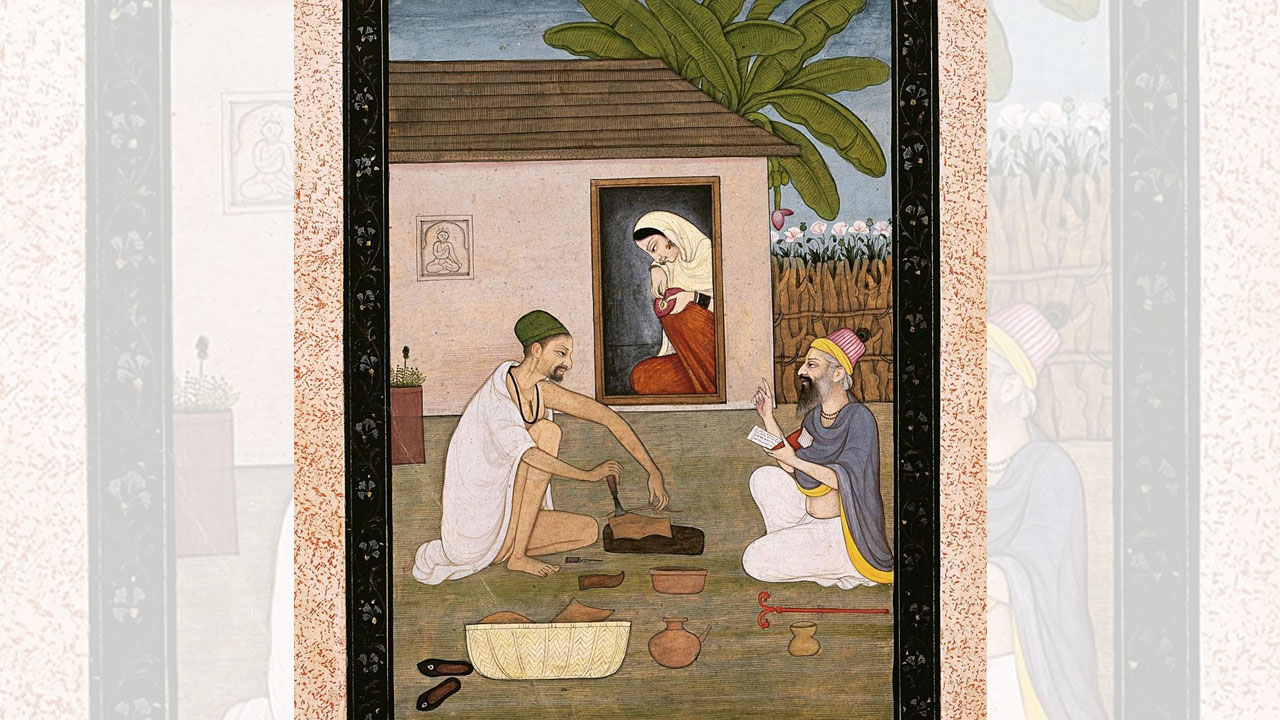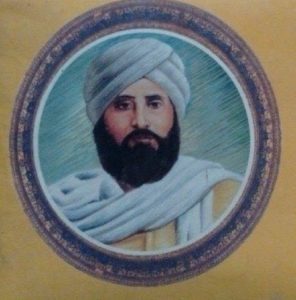
Shudron gulam rahte sadiyan guzar gayeen hain,
Julmo-sitam ko sahte, sadiyan guzar gayeen hain.
Ab to zara bicharo, sadiyan guzar gayeen hain,
Apni dasha sudharo, sadiyan guzar gayeen hain[i]
(O’ Shudras, you’ve been slaves for centuries,
For centuries you have been tolerating atrocities and oppression.
Think now, centuries have gone by,
Improve your lot, centuries have gone by)
These are the lines of Swami Achhootanand “Harihar”, who sounded the bugle of the Dalit movement in north India and founded the Adi Hindu movement.
Swami Achhootanand was born in 1879 in Umri village, Sirsaganj tehsil, in Mainpuri, Uttar PradeshHis childhood name was Heeralal. His father Motiram was a resident of Sairikh village of Farrukabad, Uttar Pradesh, but had settled in his in-laws’ village Umri after a dispute with the local Brahmins[iii].
Swami’s father and his uncle Mathura Prasad were soldiers in the British army. In the British cantonments, the doors of education were open to all. That was why Achhootanand did not face any hindrance in acquiring primary education. He studied in schools in British cantonments for 14 years and developed a good command of English and Urdu[iv].
Achhootanand’s family was Kabirpanthi. His uncle Mathura Prasad was a staunch Kabirpanthi and used to sing Kabir’s couplets to his dear nephew. Besides studying, Heeralal also spent time with sadhus. He toured the entire nation with bands of sadhus for over 10 years after completing his middle-school education and learnt languages such as Sanskrit, Gujarati, Marathi and Bengali. Due to his love for the company of sadhus, Heeralal was away from his home most of the time. His parents thought that marriage would perhaps make him stay back, so he was married to Durgabai, daughter of Ram Singh Kureel of Itawa[v]. But marriage did not kill the itinerant in him.
At that time, Arya Samaj’s movement against the birth-based Varna system was at its peak and had a huge impact on the Dalit castes. In 1905, Achhootanand came in contact with Arya Samaji ascetic Sachchidanand, became his disciple and started spreading the message of Arya Samaj[vi]. He changed his name from Heeralal to Swami Hariharanand. He stuck with Arya Samaj till 1920, and during this period he studied in depth the Vedas and Satyarth Prakash. But some incidents led him to the conclusion that the Arya Samajis and their leaders were also afflicted with the disease of Brahmanism and that their opposition to the caste system was a sham. Slowly, he became disillusioned with the Arya Samaj and ultimately quit it.
After quitting Arya Samaj, he changed his name to Harihar and started exposing the hypocrisy of the Arya Samaj. In his words:
Vedon mein bhed chhipa tha, hamein maloom na tha,
Haal poshida rakha tha, hamein maloom na tha,
‘Manu’ ne sakht the kanoon banaye ‘Harihar’,
Padhna katai mana tha, hamein maloom na tha.[vii]
(That Vedas were secretly discriminatory, we did not know,
That everything was a secret, we did not know,
Manu had framed very tough laws, “Harihar’,
That we were strictly forbidden to study, we did not know.)
From 1912 to 1917, Achhootanand, went from place to place, exposing the chicanery of the Arya Samaj. In this period, he studied the writings of saints like Kabir, Raidas and Guru Nanak. It was during this period that he realized that the Shudras were “pracheen Hind wale” (inhabitants of ancient India) and were the indigenous inhabitants of this country and that outsiders had deceitfully relegated them to a lowly position.
Hum bhi the kabhi afzal, pracheen Hind wale.
Ab hain gulam nirbal, pracheen Hind wale.
Itihaas hai batata, hai shuddh hai khoon hamara.
Par ab hain Shudra sadiyal, pracheen Hindi wale.
Bahar se kaum aayee, basne ko jo yahan par.
Sab le liya tha chalbal, pracheen Hind wale.[viii]
(There was time when the residents of ancient India were the most superior.
Now, those of ancient India are slaves and weak.
History tells us that our blood is pure.
But now the residents of ancient India are the wretched Shudras
Those who came from outside to settle here
They took everything away through deceit and force, from those of ancient India.)
Now, the Arya Samajis turned against him because he had launched a frontal attack on their religious scriptures, including Vedas, Puranas and Manusmriti, and had started questioning their claims that these treatises contained eternal truths. An Aryan Samaj sermonizer Kaviratna Pandit Akhilanand challenged him for a debate on the twin issues of relevance of Aryan doctrines and eternality of Vedic truths. Swamiji readily accepted the challenge. On 22 October 1921, the debate took place at Shahdara, Delhi, between the two and Swamiji won[ix]. An exultant Shahdara Samaj, Delhi, conferred the title of “Shri 108” on him. After this, he again changed his name and began to be addressed as Swami Achhootanand “Harihar”[x], the name by which he went on to become famous.
Adi Hindu Movement
In 1922, Swami Achhootanand launched the Adi Hindu Movement to bring awareness among the Dalits[xi].  Elaborating on the concept of Adi Hindu, he said that the word “Achhoot” means “free” or “exempt” from “chhoot” (pollution due to touch), ie sacred. He said that the Aryans defeated the valiant indigenous kings of India by use of force and through deceit and killed them. Then, they branded the indigenous inhabitants as Shudras, destroyed their culture and established a feudal social order. We (Shudras) are the descendants of the indigenous inhabitants, we are “aadivanshi” (original residents) and we have to regain our lost glory.
Elaborating on the concept of Adi Hindu, he said that the word “Achhoot” means “free” or “exempt” from “chhoot” (pollution due to touch), ie sacred. He said that the Aryans defeated the valiant indigenous kings of India by use of force and through deceit and killed them. Then, they branded the indigenous inhabitants as Shudras, destroyed their culture and established a feudal social order. We (Shudras) are the descendants of the indigenous inhabitants, we are “aadivanshi” (original residents) and we have to regain our lost glory.
Neeche giraye par ‘achhoot’, chhoot se hain ham bari,
Hum adi Hindu hain, na sankarvarna mein ham hain Hari,
Hain sabhya sabse, Hindi ke pracheen hain, haqdar ham,
Ha, ha banaya shudra hamko, the kabhi sardar ham,
Ab to nahin hain, wah zamana, zulm ‘Harihar’ mat saho,
Ab to tod do zanzeer, jakde kyon gulami main raho[xii]
(Our status was lowered, but we are exempt from pollution due to touch,
We are ancient Hindus, we are not cross-breeds,
We are the most civilized – the claimants of ancient India,
We were made Shudras, we were once the leaders,
That era has gone, O’ Harihar, do not tolerate atrocities now,
Break the chains, do not remain shackled now)
Swamiji organized several public events to take the Adi Hindu Movement forward. From 1922 to 1930, he organized eight national conventions, three special conventions, 15 provincial conventions and hundreds of district-level conventions of the Adi Hindu Movement. The first national convention was held in Delhi (1923) followed by Nagpur (1924), Hyderabad (1925), Madras (1926), Allahabad (1927), Bombay (1928), Amravati (1929) and Allahabad (1930). Provincial conventions were held in Lucknow, Kanpur, Allahabad, Meerut, Mainpuri, Mathura, Itawah, Gorakhpur, Farrukhabad and Agra[xiii]. Thousands of Dalits walked long distances from their villages to attend these conventions. Three special conventions were organized in Delhi, Meerut and Allahabad. In these meetings, Swamiji used to apprise the Dalits of his concepts of religion, society and politics.
In the 1928 convention of Adi Hindu Movement in Bombay, Achhootanand met Dr Ambedkar for the first time. Both the leaders had a long discussion on the social and political status of the Dalits. Babasaheb thanked Swamiji for lending support to the political battle he was waging for securing the rights of the Dalits. During the discussion, Ambedkar said that the movement could play a revolutionary role in politics and that such conventions should be held all over the country to build pressure on the government. This, Ambedkar opined, would force the government to bow to the demands of the Dalits.
Even as Swamiji’s movement was generating a wave of awareness among the Dalits, the Congress and the Hindus were at their wit’s end. They found Swamiji’s movement and his views unpalatable and launched a campaign against him. They severely castigated him and made attempts to sully his image. But an undeterred Swamiji continued his campaign. He knew what his objectives were. Writing about the problems Swamiji had to face, great Dalit Hindi litterateur Chandrika Prasad ‘Jigyasu’ wrote, “The Dwij Hindus were of course his enemies but the Dalits also did not help their greatest benefactor out of fear. He had to go empty stomach on many a day and had to walk for miles for want of money. But despite the hardships and the pains, he did not digress from his path. He was not the one to give up”[xiv].
Constant travel and the strain of delivering long speeches in public meetings started taking a toll on his health and he fell ill. For want of money, he could not get proper treatment and passed away at the age of 54 on 22 July 1933 at Benajhabar, near Kanpur[xv]. On his death, a poet very aptly wrote:
Ek aala dimagh than, na raha,
Aadivanshi chirag that, na raha[xvi]
(A fine brain is no more,
The lamp of original inhabitants is no more)
After his death, the Adi Hindu movement collapsed due to the lack of leadership. One faction joined the Congress and the other merged with Ambedkar’s Scheduled Caste Federation. Literature plays a key role in spreading awareness in any society. The printing presses owned by Dwijs did not publish Swamiji’s writings. That was why he established his own Adi Hindu Press in Kanpur. From 1925 to 1942, he brought out the monthly Adi Hindu, which was printed in this press. Before that, he had edited Pracheen Hindu, published from Delhi by Devilal Jatav for two years (1922-23). This was the first newspaper to be edited by a Dalit in North India. Swamiji was thus the first Dalit journalist, editor, publisher and printer of North India[xvii]. Adi Hindu Press took Swamiji’s writings to the people.
Swamiji’s literature
Swamiji’s literary journey began with poetry and ended with plays. Among his collection of poems were Harihar Bhajan Mala, Vigyan Bhajan Mala, Adi Hindu Bhajan Mala and Adivansh Ka Danka. Only Adivansh Ka Danka is now available. It is written in folk verses and includes qawwalis, ghazals, bhajans and “marsiya” (a genre of Urdu/Persian poetry which is written to lament the passing away of a great soul). The 11th and last edition of the book was published in 1983. The book is a compilation of 21 poems, most of which are recitable. This is evident from the first poem in the collection:
Adi Hindu ka danka bajate chalo.
Kaum ko neend se ab jagate chalo [xviii]
(Sound the bugle of Adi Hindu.
Wake up the community from slumber)
It is evident that Swamiji was not writing literary gems but easy-to-understand and recitable poetry which could further a social cause. Swamiji disliked the name “Harijan” given by Gandhiji to the Dalits. He expressed his opposition in the following poem:
Kiyo ‘Harijan’ pad hamein pradan.
Antyaj, patit, bahishkrit, paadaj, pancham shudra mahan.
Hum Harijan to tumahu kas na kahe, Shriman.
Kee tum hau uske jan, jinko jagat kahe shaitan.[xix]
(You have given the status of god’s people to us.
To us, the ostracized degenerates of the lowest caste who are trampled upon.
If we are Harijans, then how can we call you Harijan?
Are you the sons of those whom the world calls devils?)
Swamiji exposed the hypocrisy of the Hindu rituals:
Ram Krishna ki puja karke, chandan tilak lagate ho,
Kintu kukarmon ko karne mein, nek na kabhi lalchate ho[xx]
(You perform puja of Ram and Krishna and sport tilak of sandalwood paste
But you are not ashamed of committing sins)
In his ghazal Itihaas Gyan (Knowledge of History), Swamji tells the Dalits about their past:
Vidit sansar mein ham adi bharat ke niwasi hain.
Yahi itihaskaron ne sabhi likhkar bataya hai.
Yahan madhi Asia se Arya bankar sharnarthi aaye.
Hamara chheena ghar-jar, hamein bahuvidh sataya hai.[xxi]
(Know that we are the inhabitants of ancient India.
This is what all historians have written.
Aryans came here from Central Asia.
They snatched our homes from us and tortured us in various ways.)
In his qawwali Manismriti Se Jalan, (The scalding Manusmriti) he has ripped apart the ancient penal code and even cursed the Hindu society.
Nish din Manusmriti ye hamko jala rahi hai,
Upar na uthne detee, neeche gira rahi hai,
Aey Hindu kaum! Sun le, tera bhala na hoga,
Jo bekason ko ‘Harihar’ gar tu rula rahi hai.[xxii]
(This Manusmiriti is scalding us every day,
It is not allowing us to rise; it is pushing us down,
Hindu community listen, nothing good will come to you,
If O’ Harihar you will torture the helpless.)
The speciality of Swamiji’s poems is that they are in simple Hindi and are straightforward. Their primary objective is to create awareness and consciousness among the Dalits. The poems also betray a deep angst, which is only natural. According to Prof Chaman Lal, “Swami Achhootanand’s poems are in the traditional format and have been written in pursuance of an objective”[xxiii].
Another poetic work of Achhootanand is a Khandkavya (a collection of poems focusing on only a particular aspect of a character’s life – as distinct from mahakavya or epics) called Adi Khand. It narrates the story of the rise and fall of Dalits in brief. The book was published in 1929[xxiv]. It is in a folk verse called “Aalaha” and begins with remembering Satguru Swami.
Pehle Satguru Swami, deenha laukik aatam gyan.
Brahma roop chetan ghat-ghat mein, vyapak sakal srishti darmayan[xxv]
(I begin with remembering Satguru Swami, who gave knowledge about the world and the soul.
The consciousness of Brahma permeates the entire creation)
 Two of Swamiji’s plays have survived. They are Ram Rajya Nyay and Mayanand Balidan. He wrote them in the folk Nautanki style in 1926 and 1927 respectively[xxvi]. These plays established Dalit theatre in Hindi. Ram Rajya relates the tale of Shudra Rishi Shambuk. The rishi used to spread awareness among the Dalits about the injustice inherent in the Varna system. The Brahmins declared that this was against religion and advised the king Ram to kill Shambuk as a punishment. Ram accepted the advice and went to Shambuk’s ashram and killed him. When Dalit actors staged this play, they created tumult. For the first time they saw the real face of their so-called god Ram.
Two of Swamiji’s plays have survived. They are Ram Rajya Nyay and Mayanand Balidan. He wrote them in the folk Nautanki style in 1926 and 1927 respectively[xxvi]. These plays established Dalit theatre in Hindi. Ram Rajya relates the tale of Shudra Rishi Shambuk. The rishi used to spread awareness among the Dalits about the injustice inherent in the Varna system. The Brahmins declared that this was against religion and advised the king Ram to kill Shambuk as a punishment. Ram accepted the advice and went to Shambuk’s ashram and killed him. When Dalit actors staged this play, they created tumult. For the first time they saw the real face of their so-called god Ram.
Swamiji’s second play Mayanand Balidan is entirely in verse. It is about the tradition of human sacrifice in Hindu religion. It relates a tale of Gujarat where in Vikram Samvat 1300, brahmanical rulers sacrificed an Untouchable, Sadhu Mayanand, during a yagna held to pray for rain. The play shows how Dalits became victims of the Brahmins’ cultural imperialism.
The movement launched by Swami Achhootanand “Harihar” was the first Dalit movement of the Hindi belt. It was both political and social and its objective was to arouse society. He took the aid of literature to take his movement forward, which, knowingly or unknowingly led to the emergence of a new literary movement. Swamiji was also the first Dalit journalist, editor and owner of a printing press in North India. His journalism was the base on which the present-day Hindi Dalit literary movement was built. He was the first Dalit litterateur of the Hindi belt who wrote in “khadi boli” and whose writings display a maturity of style. He is credited with establishing Dalit theatre in the Hindi belt. According to Prof Chaman Lal, “With the writings of Swami Achhootanand’s coming to light, he can well be called the progenitor of modern Dalit literature in Hindi, with Heera Dom’s poetic works coming next”[xxvii]. Thus Swamiji laid the foundation of the social and literary Dalit movement in the Hindi belt. His work will be relevant as long as the discrimination in the name of caste remains in India society. That is why he is as relevant today as he was in his time.
References
[i] Swami Achhootanand ji ‘Harihar’ Sanchayita, ed Kanwal Bharti, Swaraj Prakashan, 7/14 Gupta Lane, Ansari Road, Dariyagang, New Delhi – 110 002, 2011Edition, p 150
[ii] Ram-Rajya-Nyaya Natak, Swami Achhootanand ji Harihar, ed Swaroop Chandra Boudhha, Samyak Prakashan, Paschimpuri, New Delhi, 2006 Edition, Page 3
[iii] Swami Achhootnand ji ‘Harihar’ Aur Hindi Navjagran, Kanwal Bharti, Swaraj Prakashan, 7/14 Gupta Lane, Ansari Road, Dariyganj, New Delhi – 110002, 2011 edition, p 172
[iv] Ibid, p 174
[v] Ibid, p 175
[vi] Ibid, p 175
[vii] Ram-Rajya-Nyaya Natak, Swami Achhootanand ji Harihar, ed. Swaroop Chandra Boudhha, p 5
[viii] Ibid, p 5
[ix] Swami Achhootnand ji ‘Harihar’ Aur Hindi Navjagran, Kanwal Bharti, p 190
[x] Ibid, p 190
[xi] Ibid, p 190
[xii]Ibid, p 186
[xiii]Swami Achhootanand ji ‘Harihar’ Sanchayita, ed Kanwal Bharti, p 33
[xiv]Swami Achhootnand ji ‘Harihar’ Aur Hindi Navjagran, Kanwal Bharti, p 184
[xv] Ram-Rajya-Nyaya Natak, Swami Achhootanand ji Harihar, ed Swaroop Chandra Boudhha p 20
[xvi]Ibid p 20
[xvii]Swami Achhootnand ji ‘Harihar’ Aur Hindi Navjagran, Kanwal Bharati, p 20
[xviii]Adivansh Ka Danka, Shri 108 Swami Achhootanand ji Harihar, Bahujan Kalyan Prakashan, Saadanganj, Lucknow, 1983 edition, p 1
[xix]Ibid p 4
[xx]Ibid p 4
[xxi]Ibid p 10
[xxii]Ibid p 14
[xxiii]Dalit Sahitya Ek Mulayankan, Prof Chaman Lal, Rajpal and Sons, Kashmiri Gate, Delhi, 2009 Edition, p 64
[xxiv]Swami Achhootnand ji ‘Harihar’ Aur Hindi Navjagran, Kanwal Bharti, p 240
[xxv]Ibid, p 241
[xxvi]Ibid, p 254
[xxvii]Dalit Sahitya Ek Mulayankan, Prof Chaman Lal, p 63


